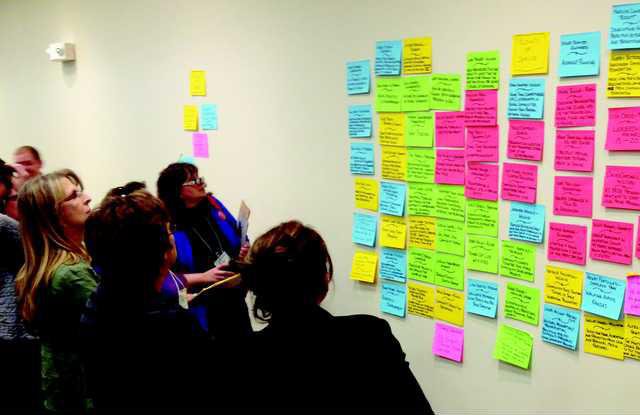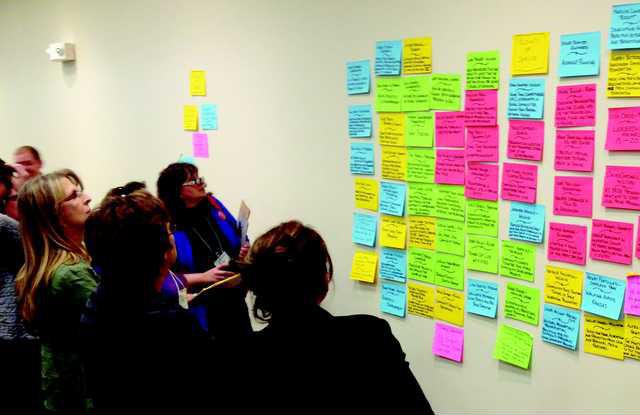The room was filled with a few hundred passionate rural leaders eager to solve problems and create initiatives to improve the lives of rural residents. Enthusiasm hung in the air.
Twenty round tables were filled with barely a chair to be found by late comers as the storm got brewing Friday morning, March 14, at Newton’s Meridian Events Center. The Big Rural Brainstorm, that is. It was the second in three years, brought back by popular demand following the 2012 BRB project of the Kansas Sampler Foundation.
The first succeeded in bringing together grassroots rural advocates from all walks of life, and served as a launching pad for a growing group of young organizers who call themselves “PowerUps,” people ages 21-39 who identify with the tag-line “rural by choice.”
“PowerUps took a leadership role in planning the conference and in participating in the conference—and it changed the shape of the conference in a positive way,” said Marci Penner, executive director of the Kansas Sampler Foundation, in an email following the conference. “If every conference would work towards a goal of having their roster be one-third PowerUps and encourage their voice to be heard in a meaningful manner, then, I believe, definite progress would be made in moving rural Kansas forward.”
Issues tackled included walking and biking around Kansas in order to increase tourism and to help Kansans become healthier, what to do when a community loses it’s only school, repurposing buildings like school houses and grain elevators, attracting healthy food businesses, doctors, and retailers to rural towns and keeping and building access to the internet and cutting edge technology. But above all, there was an underlying interest in learning what it takes to keep a small community alive.
Thinking outside the box was encouraged, and some groups went rogue, formulating answers to some of the unique problems facing rural Kansas towns operating on shoestring budgets and the passion of volunteers.
Burdett pilot project
To help demonstrate the power of brainstorming and to demonstrate the rules, Penner and Lauren Long of Larned introduced a project already in the works in Burdett, a town with a population of about 250 people in Pawnee County. It’s home to Moosette’s Cafe and a unique free miniature golf course.
Penner asked the group to brainstorm out of the box ideas to revamp the holes of the course in order to transform Burdett into a destination for Kansas explorers to visit.
Ideas began to fly.
Those receiving enthusiastic applause included the addition of a geocache to the course, allowing it to travel along Main Street, and inviting other small towns in rural Kansas to create a hole representing their towns, so players would enjoy a virtual tour of rural Kansas.
Negative (canned) comments like “That won’t work,” “Who’s going to pay for that?” and “We already tried something like that,” received the “yellow card,” redirecting the conversation back towards positive, idea generating activity.
Penner explained the project has already been identified as a pilot for Kansas Sampler’s latest rural promotion tool, Kanstarter, which is being developed with the help of Reflective Group,LLC, a web hosting and design company from Baldwin City. Fashioned after the popular crowd-funding site Kickstarter.com, Kanstarter will focus on funding Kansas-based projects.
“The idea is to put the call out to the world, especially alumni and Kansas natives, so they can easily see the projects being undertaken in small towns and then donate with one click,” Penner explained in an email. “We need to make it easy for them to be involved.”
Storms
While the BRB was broken up into five separate storms, Penner encouraged groups that were onto something to “go rogue.” That meant they could find a space to continue their discussions uninterrupted.
A group interested in food and beverage tourism formed, as did a group of economic development and visitors bureau professionals from several small towns. Sometime in the future, a new website listing destination cafe’s and bars may materialize. And guidelines for creating perfect sunset viewing areas around the state were nailed down, and will soon be available on the Kansas Sampler website.
Each storm had a list of topics attendees could discuss. They ran the gamut from, “When attracting five jobs is as important as attracting 500: how does the volunteer-led town market opportunities?” to “We may be rural, but we have the need for speed! Is it reasonable to fight for high speed access - and how do we do that?” to “How much is made-from-scratch worth? Can it be the identity for a string of local cafes or for a whole town?”
Get-in-front
Storm three focused on specific ideas attendees designated at registration. The authors of these ‘Get-in-front” topics were given 30 seconds to pitch their idea before the session started, and then attendees moved to the conversation that appealed to them.
Patrick Hoffman, Ellsworth Chamber of Commerce, led a discussion on the future of retail in rural towns, specifically on how the internet was changing the retail landscape. Jennifer Arnold, Girl Scouts Kansas Heartland, talked about how to develop youth into PowerUps, and Diana Kirk, Wichita County Economic Develpment and a resident of Leoti, led a discussion about The Pocket Change Program, a housing plan where communities work together to create the volume that would attract developers to build rural.
Media representatives, too, were in attendance, answering attendees’ questions about how to approach the media with information about their organizations. They also discussed ways to bring more positive media exposure to Kansas to counteract the pervasive negative attention the state has received in years past.
PowerUps talk
Storm four was all about PowerUps providing answers. Experienced organizers had the chance to ask the questions, “What attracts a PowerUp to a community,” How can we bridge the gap between the older folks (70ish) with the PowerUps,” “What community activities interest PowerUps as participants,” and “”What should rural communities do to attract young people and families?”
The answers were sometimes surprising. PowerUps Luke Mahin with Republic County Economic Development and Stephanie Simmons with AWARE NCK, explained that young people, often decide first where they want to live, and then look for a job that will fit them.
“We work to live, not live to work,” Mahin said.
Keeping in touch with young people after they leave for college, and letting them know when there is a job opening that they might like is one good way to encourage them to come back. But the message needs to start young, Mahin said.
“If you grow up hearing “there isn’t anything here,” then when it’s time to decide where to work, you’ll likely not come back.” Mahin returned to his hometown of Courtland after graduating from Fort Hays, as have many of his friends he’s grown up with, because the community has kept it at the forefront that they are wanted and valuable, he said. Courtland is a town of a few hundred people in North Central Kansas.
As the day drew to an end, attendees lined up to share the actions they planned to continue working on when they returned to their communities. And the Kansas Sampler Foundation promised to keep attendees apprised of their progress, until the next BRB hits sometime in the future.
POWERFUL STORM
Big Rural Brainstorm brewing ideas, solutions





